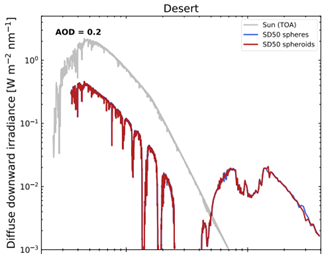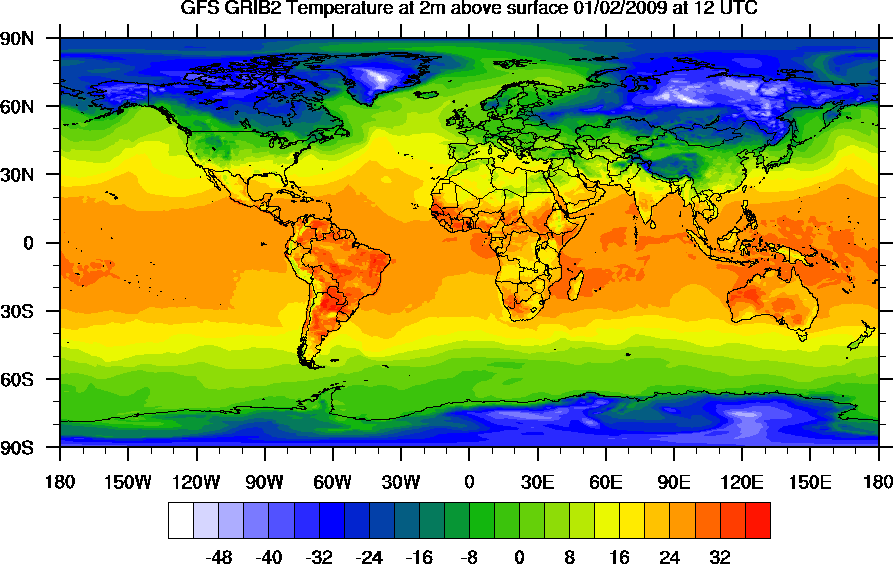Scattering databases
The remote sensing work of ReACT involves the utilization of advanced scattering databases (e.g. Dubovik et al., 2006; Gasteiger and Wiegner, 2018).
Our research interests focus mainly on the scattering properties of dust particles, since currently there is no complete solution for calculating the scattering properties of the whole range of dust sizes, shapes and refractive indices. For this reason, the group is developing a new dust scattering database (Tsekeri et al., 2019) that takes into account realistic-shaped dust particles and a size range that includes most of the coarse mode of dust. In particular, we have used the irregular shapes of Gasteiger et al. (2011), a size range of particle radii of 0.001-5 μm for Visible light applications or 0.002-10 μm for NIR light applications, and four refractive indices with values of 1.48-1.6+i0-0.002. The scattering calculations were performed with the Amsterdam Discrete Dipole Approximation (ADDA) (Yurkin and Hoekstra, 2011) using High Performance Computing (HPC) systems.

Irregular shapes of dust particles considered in the ReACT dust scattering database (Source: Gasteiger et al., 2011)
Moreover, the unique characteristics of the scattering of smoke particles from large-scale fires in the stratosphere is investigated, using particles with near-spherical shapes (Gialitaki et al., 2020).

Near-spherical shapes used for reproducing the unique scattering properties of the smoke particles from large-scale fires in the Stratosphere (Source: Gialitaki et al., 2020)
Acknowledgements:
The work is supported by the European Research Council under the European Community’s Horizon 2020 research and innovation framework program/ERC grant agreement 725698 (D-TECT). We acknowledge PRACE for awarding us access to MareNostrum at Barcelona Supercomputing Center (BSC), Spain. The work was supported by computational time granted from the Greek Research & Technology Network (GRNET) in the National HPC facility - ARIS - under project ID pa170906-ADDAPAS, pr005038-REMOD and pr009019-EXEED.
-Dr. Alexandra Tsekeri
References:
Dubovik, O., Sinyuk, A., Lapyonok, T., Holben, B. N., Mishchenko, M., Yang, P., Eck, T. F., Volten, H., Muñoz, O., Veihelmann, B., van der Zande, W. J., Leon, J., Sorokin, M., and Slutsker, I.: Application of spheroid models to account for aerosol particle nonsphericity in remote sensing of desert dust, J. Geophys. Res., 111, D11208, https://doi.org/10.1029/2005JD006619, 2006.
Gasteiger, J., Wiegner, M., Groß, S., Freudenthaler, V., Toledano, C., Tesche, M., and Kandler, K.: Modeling lidar-relevant optical properties of complex mineral dust aerosols, Tellus B, 63, 725–741, https://doi.org/10.1111/j.1600-0889.2011.00559.x, 2011.
Gasteiger, J. and Wiegner, M.: MOPSMAP v1.0: a versatile tool for the modeling of aerosol optical properties, Geosci. Model Dev., 11, 2739–2762, https://doi.org/10.5194/gmd-11-2739-2018, 2018.
Gialitaki, A., Tsekeri, A., Amiridis, V., Ceolato, R., Paulien, L., Kampouri, A., Gkikas, A., Solomos, S., Marinou, E., Haarig, M., Baars, H., Ansmann, A., Lapyonok, T., Lopatin, A., Dubovik, O., Groß, S., Wirth, M., Tsichla, M., Tsikoudi, I., and Balis, D.: Is the near-spherical shape the “new black” for smoke?, Atmos. Chem. Phys., 20, 14005–14021, https://doi.org/10.5194/acp-20-14005-2020, 2020.
Tsekeri, A., Gasteiger, J., Konoshonkin, A., Kustova, N., Georgiou, Th. and Amiridis, V.: Scattering database of oriented dust particles with realistic shapes and sizes, APOLO-2019, Lille, France, 4-7 November 2019.
Yurkin, M. A., and Hoekstra, A. G.: The discrete-dipole-approximation code ADDA: capabilities and known limitations. Quant. Spectrosc. Radiat. 112, 2234–2247, 2011.
Radiative transfer
The radiative transfer work of ReACT focuses on determining the radiative effects of mineral dust in the atmosphere by probing more realistic microphysical properties in terms of grain sizes and shapes, appropriate scattering calculations and thus more accurate description of the dust optical properties. For the radiative transfer calculations we utilize advanced radiative transfer schemes, as the MYSTIC solver of libRadtran (Emde and Mayer, 2007; Mayer 2009, Mayer et al., 2010).
Our recent work focuses on the quantification of the effect of the large sizes of dust particles on cooling or warming the Earth’s atmosphere.

ReACT radiative transfer calculations at the top of the atmosphere (TOA) for dust particles with large sizes, considering spherical (blue line) and spheroidal shapes (red line)
Acknowledgements:
The work is supported by the European Research Council under the European Community’s Horizon 2020 research and innovation framework program/ERC grant agreement 725698 (D-TECT). We acknowledge PRACE for awarding us access to MareNostrum at Barcelona Supercomputing Center (BSC), Spain. The work was supported by computational time granted from the Greek Research & Technology Network (GRNET) in the National HPC facility - ARIS - under project ID pa170906-ADDAPAS, pr005038-REMOD and pr009019-EXEED.
-Dr. Alexandra Tsekeri
References:
Emde, C. and Mayer, B.: Simulation of solar radiation during a total eclipse: a challenge for radiative transfer, Atmos. Chem. Phys.,
7, 2259–2270, doi:10.5194/acp-7-2259-2007, 2007.
Mayer, B.: Radiative transfer in the cloudy atmosphere, Eur. Phys. J. Conferences, 1, 75–99, 2009.
Mayer, B., Hoch, S. W., and Whiteman, C. D.: Validating the MYSTIC three-dimensional radiative transfer model with observations from the complex topography of Arizona's Meteor Crater, Atmos. Chem. Phys., 10, 8685–8696, https://doi.org/10.5194/acp-10-8685-2010, 2010.

